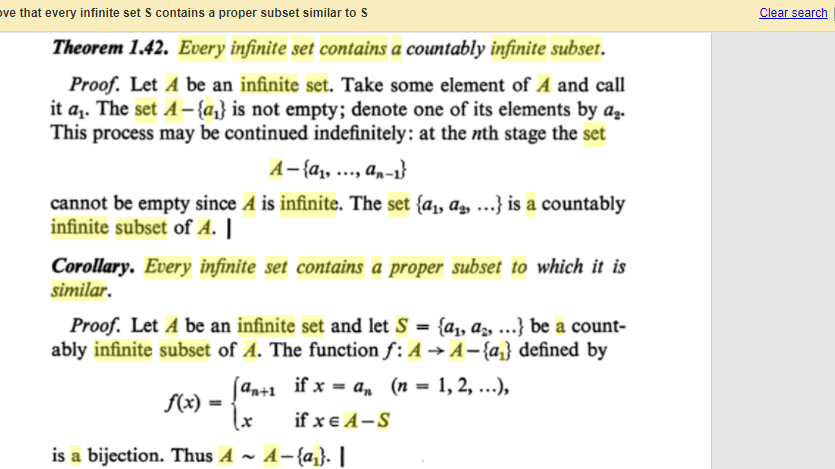Corollary. Every infinite set contains a proper subset to which it is similar. Proof. Let A be an infinite set and let S = {a, az, ..} be a count- ably infinite subset of A. The function f: A → A-{a;} defined by (an+1 if x = a, (n = 1, 2, ...), if x € A-S %3D f(x) = (x is a bijection. Thus A ~ A-{a,}. |
Corollary. Every infinite set contains a proper subset to which it is similar. Proof. Let A be an infinite set and let S = {a, az, ..} be a count- ably infinite subset of A. The function f: A → A-{a;} defined by (an+1 if x = a, (n = 1, 2, ...), if x € A-S %3D f(x) = (x is a bijection. Thus A ~ A-{a,}. |
Elements Of Modern Algebra
8th Edition
ISBN:9781285463230
Author:Gilbert, Linda, Jimmie
Publisher:Gilbert, Linda, Jimmie
Chapter2: The Integers
Section2.2: Mathematical Induction
Problem 40E: Exercise can be generalized as follows: If and the set has elements, then the number of elements...
Related questions
Question
Show in detail that f is a bijection (Corollary's proof)

Transcribed Image Text:ove that every infinite set S contains a proper subset similar to S
Clear search
Theorem 1.42. Every infinite set contains a countably infinite subset.
Proof. Let A be an infinite set. Take some element of A and call
it az. The set A-{az} is not empty; denote one of its elements by az.
This process may be continued indefinitely: at the nth stage the set
A-{a1, ..., an-1}
cannot be empty since A is infinite. The set {a,, a„ ..} is a countably
infinite subset of A. ||
Corollary. Every infinite set contains a proper subset to which it is
similar.
Proof. Let A be an infinite set and let S = {a, az, ..} be a count-
ably infinite subset of A. The function f: A → A-{az} defined by
%3D
(an+1 if x = a, (n = 1, 2, ..),
f(x)
if x e A-S
is a bijection. Thus A ~ A-{az}. |
Expert Solution
This question has been solved!
Explore an expertly crafted, step-by-step solution for a thorough understanding of key concepts.
This is a popular solution!
Trending now
This is a popular solution!
Step by step
Solved in 3 steps with 1 images

Recommended textbooks for you

Elements Of Modern Algebra
Algebra
ISBN:
9781285463230
Author:
Gilbert, Linda, Jimmie
Publisher:
Cengage Learning,

Elements Of Modern Algebra
Algebra
ISBN:
9781285463230
Author:
Gilbert, Linda, Jimmie
Publisher:
Cengage Learning,